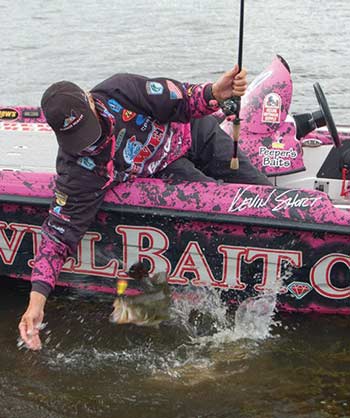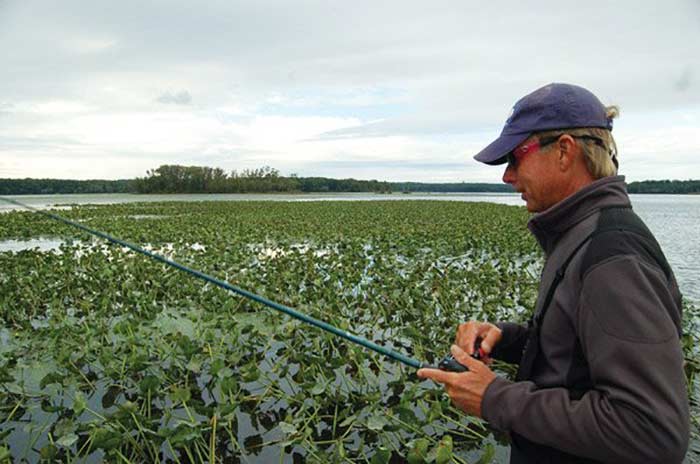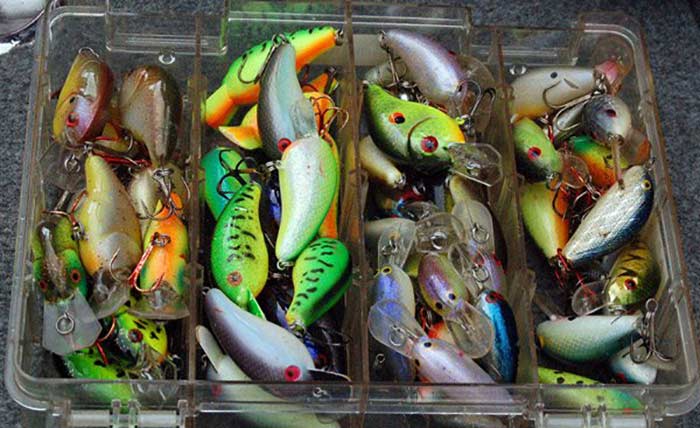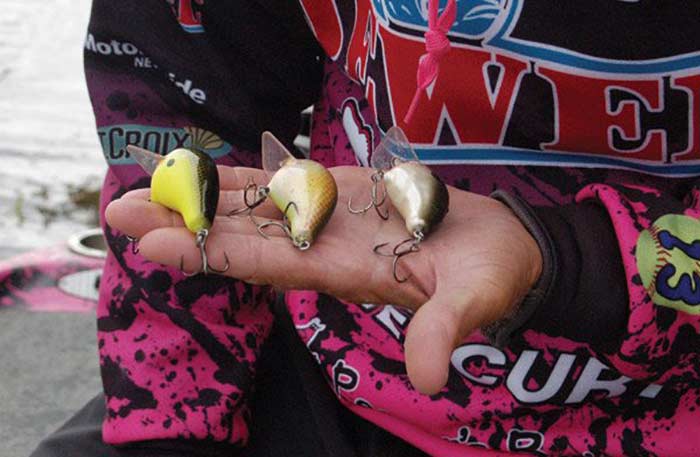Advertisement
Ten quick steps to break down any river in the country.

When the Bassmaster Elite Series visited Pickwick Lake in the spring of 2010, no one bothered to tell Arkansas pro Kevin Short the whole name of the body of water.
It's a lake, Kevin. L-A-K-E. You know, the big, bowl-shaped suckers?
Perhaps he was still giddy from his first Elite Series victory a year earlier, on the Mississippi River out of Ft. Madison, Iowa, a stingy affair that left many top pros scratching their heads. Even the immortal KVD blanked one day there.
Good thing for Mr. Short that he's a little bit of a rebel. He’d been to Pickwick before, so he no doubt knew about the four-letter word. Still, he decided to play a little Jedi mind trick on himself and treat the big southern impoundment more like a river. It paid off — to the tune of $100,000.
Short spent four days in a backwater where current created by the TVA positioned the fish among a series of cypress trees. He wreaked havoc with one of his favorite Arkansas River crankbaits. On a Day Four shortened by inclement weather, he brought in 23 pounds, 5 ounces, the biggest bag of the whole rodeo.

River rats are an odd breed. You can usually pick them out by the lack of paint on their outboard skegs, the littered grass and branches in the bottom of their boats, and a look of confusion whenever their trolling motors aren't kicking up mud. Pros like Short can catch big bags in deep water, and they can catch 'em on lakes, but they're most in their element doing hand-to-fish combat in water shallower than their crankbait rods.
Short has fished tidal rivers on both coasts, the famous lock-and-dam behemoths that litter the middle of the country and a good number of free-flowing waters. You can bet that when he sees one on his tournament schedule he puts more stars next to it than a pre-teen uses to mark a Miley Cyrus concert. Here are the steps he takes to break down a river of any type, anywhere, any time:
1. Think clarity.
The first thing Short looks to learn when he gets to any new river system is the dominant water color or clarity. Then he tries to find something different.
"I want to know if the majority of the water is clear or if the majority is dirty," he explained. "If it's mostly clear to stained, then I'll look for something dirtier. Not the dirtiest water in the system, but water with color. If the river is mostly stained to muddy, then I'll try to find the clearest water I can."
2. Focus on cover.
Once he's established a starting area based on water clarity, Short looks for the elements within that area that are likely to hold fish. Unlike traditional lakes, where bass may relate to channel drops, deep sloping points or other major contour changes, Short's second step is focused on cover, not structure.
"Usually that's either some sort of hard object — rock or wood — or something soft, like vegetation," he said. "My preference is wood. But someplace like the Potomac, where the grass is so strong, I don't even look for wood unless it's a place where there was grass previously and then it's all gone."

In some places, a combination of hard and soft cover will play a role in his game plan. For example, on his home river, the Arkansas, he knows that the fish consistently relate to both. If he finds them both in a concentrated area, he'll pound it out until he figures out which they prefer.
"River fish don't move real far," he said. "They do all of their business, and often live their entire lives, in small areas. They don't swim all the way over to the other side of the river just to spawn."
3. Which part of the river?
Short has won tournaments fishing main river cover, he's won them fishing major tributaries and he's won in isolated backwaters, so he's not necessarily partial to one over the other, but he has a theory that guides his fish-finding efforts.
"As a general rule, the biggest concentrations of the largest fish are main river fish," he said. "But they are also at times the hardest to catch because things change on the main river more than in the creeks.
"In the creeks, there's often more quantity and they're easier to catch, easier to target, but you won't have the quality," he continued.
It also pays to do a little bit of pre-scouting research: "On the Arkansas, 85 to 90 percent of tournaments are won on the main river or somewhere really close. On the Potomac, both the river and the creeks are pretty good. On the Red River, it's usually the backwaters. You need to find both if you can."
4. The flow matters.
What separates rivers from many if not most lakes is that there's a constant flow. Whether it's generated by the opening and closing of dams, tidal influence, or some other factor, it's often critical in determining whether the bass set up and how they relate to their preferred cover.
Advertisement
"It's seasonally specific," Short said. "In the spring, a lot of times they'll set up to spawn on big flats near the mouth of a major creek, places where you don't see a lot of current. But in the summer and the fall they want to be around points or anything else that puts them close to current."
When the fish are in or adjacent to the heavy flow, it allows Short to further break down which areas are likely to hold the greatest concentrations of fish.
"If you have a huge grass flat, I like one with clumps and some open areas rather than just a solid mat," he said. "They want to be around points or clumps, something with current coming around it. You have to have an edge, especially when you're talking about grass."
5. Be around the bait.
Creatures living in current — whether they be bass, stripers, rough fish or anything else —have to act decisively or they won't survive long. It's an ecosystem that doesn't allow for dilly-dallying or spending time in infertile areas. In other words, the bass have no business being where there's no prey to eat.
"If everything looks right but there are no shad, it's probably not going to be productive," Short said. "Everything in a river system follows the food around."
Those key food sources often serve as nutrition for more than one species. Particularly when fishing main river cover, Short often finds bass mixed in with stripers, white bass and other predators. He knows he's probably in a productive area when he can see and hear the bait working.
"I want to see them up on top," he said. "Those are usually the most productive areas, any place where you hear them flipping or see them moving, regardless of water color." It's not just shad, either, although that's the most common forage — bluegills, perch and a variety of other finfish play key roles in river systems and when Short sees them around the preferred cover he'll tailor his lure colors accordingly.
6. Lures that produce — and know when to go small.
While Short carries more lures in his Bass Cat than a well-stocked tackle store, certain basics are always tied on when he hits the water on a river system. The four non-negotiables are as follows:
- A jig to flip around hard cover and into holes in the grass, usually a Jewel J-Lock flipping jig with a Zoom Speed Craw trailer;
- A War Eagle spinnerbait, with skirt color and blade configuration tailored to the water color and prevalent forage;
- "If there's any wood at all," a WEC E1 shallow diving crankbait; and
- A Mann's One Minus, an ultra-shallow diver that can be burned on grass flats.

He keeps his color choices simple. "The clearer the water, the more natural I'll go," he said. "If the water is gin clear, I'm not going to use a chartreuse black back crankbait as a general rule. I'll go to something like a Tennessee Shad or silver or white."
With the exception of places like the San Joaquin River Delta in California, where there's a wide range of forage sizes, Short noted that at many times of the year river bass feed on diminutive prey. Accordingly, he often relies on downsized crankbaits — lures like the Norman Baby N and Deep Tiny N — when confronted with such circumstances. That's not just on stingy grind 'em out fisheries like the Ohio River, but also on waters that occasionally produce 20-pound bags, like the Potomac, the Arkansas and the Red.
"Power techniques usually win tournaments, but finesse has its place, too," he added. He pointed to this past summer's Elite Series event on the Arkansas River where Aaron Martens dropshotted and shakey-headed for four days and nearly stole the victory away from a jig-slinging Denny Brauer.

Short also has a few tackle tricks that he only pulls out in river fishing situations. For example, a jet black crankbait is one of his go-to baits on the Arkansas River, as is a double-propped topwater. Any time he's around dirty water and current, he replaces the regular silicone skirts on his spinnerbaits with old-school flat rubber skirts that pulsate and move more water.
7. Stay shallow.
The reason nearly all of the river rats have paint-free skegs is because the fish tend to live shallow year-round. In fact, there are times when there’s no such thing as too shallow. "On lots of rivers, I don't think you can get your boat to a lot of the fish," he said. He’s caught them in inches of water, with their backs sticking out of the drink.
"Typically, if you're fishing more than 6 or 7 feet, you're fishing below 80-90 percent of the fish," he added. Unlike lakes, where fish have to go deep in the heat of the summer to stay cool, Short said on rivers the fish can consistently remain in less than five feet of water. "It'll be cooler than the lake right next to it. They don't have to go deep to stay cool. There will be plenty of oxygen.
"That's not to say that you can't catch them 12 to 15 feet deep on some river systems at certain times and in certain places, but on most of them zero to 7 feet is it."
8. The drain's the game.
Because he's typically dealing with an expanse of water top-to-bottom that's shorter than his flipping stick, Short said that the importance of subtle depth changes can be greatly magnified. Particularly when water levels are changing due to the tide or influence of lock and dam operations, subtle edges are critical in determining how fish are positioned.
Advertisement
"For example, on the Potomac, if you are fishing a big grass bed, if there's any kind of ditch in it, even something six inches deeper, the changing water level is extremely important. When the tide bottoms out, everything comes to the edge.
"The same thing happens if the river has dams and they're monkeying with the water levels," he continued. "In a three- or four-day tournament, a lot of times they'll drop the water level and everybody goes to the drop. In either of those situations, you're looking for drains that pull the fish to them."
9. Have a punt pattern.
Grass, rock or laydown wood may be the dominant fish-holding cover on a given river system at a particular time, but when the bite freefalls and livewells are empty, Short has certain fallbacks that help him eke out additional bites.
"It's usually man-made stuff," he said. "Every river has some type of man-made structures. A lot of times for me it can be riprap around bridges or water discharges. It's not 100 percent guaranteed, but about 99 percent of the time you'll catch something around them."
The water discharges in particular draw him like moths to a flame. They can be from a variety of sources, everything from power plants to storm drains. "They don't even need to have water coming out of them," he said. "Most are on the outside bends of the river. They act as current breaks."
10. Make sure you can get there ... and back.
The flow which makes river systems productive can also make them extremely dangerous. Previously passable areas get silted in. Rocks, logs and all manner of detritus shift, not just from day to day, but also from hour to hour. Even with the best contour maps and GPS mapping systems, it still pays to be exceptionally careful.
"If I've never been there before and I don't know my way around, any time I'm out of the channel and it's unmarked, I'm not running unless it's 20 feet deep," he said. "In fact, if it's 10 feet or less, I'll probably idle it every time until I know there's nothing there."
On some systems, he'll idle just about every time he's out of the marked channel, even after years of running. The Red River is one example. Even his home waters of the Arkansas, where he's spent countless hours over a lifetime of fishing, occasionally give him pause.
"It's bad in places," he said. "There's lots of unmarked underwater rock. It'll be on the navigation chart but not on the GPS. It ain't going to move when you hit it."
Obviously, in these situations, discretion is the better part of valor.
Short's Superlatives
Favorite river: "The Arkansas. It has everything — grass, rock, wood, even deep drops. There’s clear water and muddy water. The Potomac is great, too, but it's all pretty much the same. Because of the locks and dams, the pools (on the Arkansas) are all very different. I suppose if you could fish the Mississippi from top to bottom it has the same diversity."
River you never want to see again: "I don't know that I've ever been to one that I wouldn't go back to, but if forced to choose I'd probably say the Ouachita near Monroe, La. At certain times of the year, 9 or 10 pounds is really strong there."
River you'd want to fish a tournament on if your life depended on it: "Pool 18 of the Mississippi in Iowa. There's a whole lot of water there that I didn't fish in the tournament (that I won) that I know has to hold fish at some times. And it's tough — not everybody can catch those fish."
Best grass river: "For quality, it would have to be the California Delta. For quantity, the Potomac."
Best cranking river: "The Red and the Mississippi"
Best topwater river: "The Arkansas, with a prop bait, when it's hot. I mean bright sun, no wind, slick water, sweat running down the back of your knees."
Most hazardous river: "Probably the Ouachita. It's just a nasty place."
Prettiest river: "The St. Lawrence. Between the water color and all of the islands, the area along the U.S.-Canada border is beautiful."
